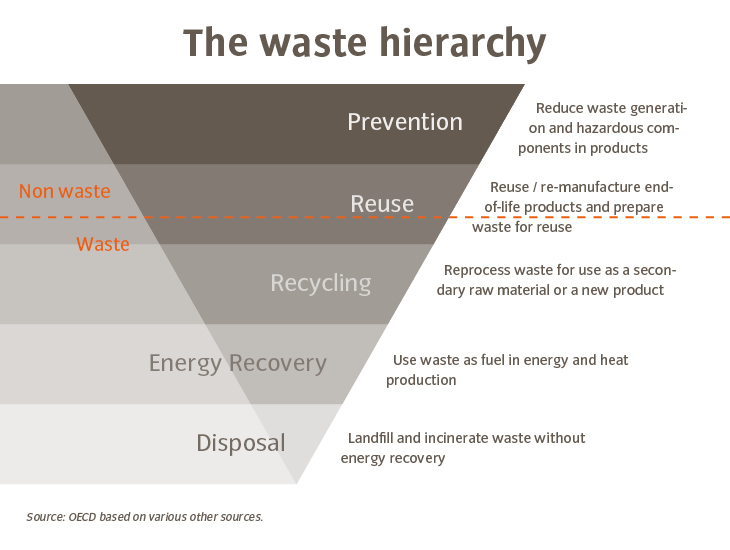
Goal: Reducing Residual Waste
“Rubbish” or raw materials?
"Rubbish" is a key environmental issue. For one, it means that limited resources are wasted. For another, some types of waste (such as plastic bags or synthetic microparticles that end up in the oceans) pose a serious threat to wildlife. Read more about it here.
Last but not least, hazardous substances can be released into the environment if waste is not disposed of properly.
Avoiding waste as far as possible

Despite the fact that waste management is already very well regulated in Germany, it is still an important environmental issue.
All waste is collected by local waste management companies and properly disposed of, or it is brought to a collection station by VAUDE employees with documented proof.
Some of the fabric remnants (polyethylene) from products at the Obereisenbach site is collected separately and passed on to a recycling company.
Waste at VAUDE
Create your own infographicsResidual waste continues to be our "problem child"
At VAUDE, residual waste is primarily generated in our Manufaktur production facility and includes textile remnants from die-cutting or, at times, semi-finished products that have not passed our strict quality control. Much of this ends up in our upcycling program (more about this here), the rest goes into the residual waste system.
Waste from marketing events for which sorting would be too complex as well as products from our repair service that can no longer be repaired and cannot be used as a second hand products are also disposed of as residual waste. The criteria we use to sort such products are taken directly from the non-profit organization FairWertung, where we donate all products that can still be used. More about this here.
Thermal Recycling
Nevertheless, we still have far too much residual waste that is not recycled but "thermally recovered" – incinerated as fuel for energy-intensive industries such as cement production or energy generation.
This is better than not using residual waste at all, but of course, it would be much better from an ecological standpoint if we reduced our residual waste as much as possible.
This is why we are trying to scale down material remnants in the manufactory by optimizing cutting processes. And we are looking for industrial partners who can use coated plastics for recycling despite the relatively small quantity - so far without success. There are two issues here – our quantities are quite small on an industrial scale and TPU-coated polyester materials are not homogeneous and therefore a real challenge for recyclers.
Residual Waste (t)
Create your own infographicsUpcycling: Environmental protection with social benefits
Under the motto "From residual material to raw material" we have founded a small, exclusive Upcycling Workshop in which we produce beautiful and useful products with creative ideas and craftsmanship – each one truly unique! A positive side effect is that the project has also created jobs for refugees. Read more about it here.
Waste compared to company growth
Unfortunately, the amount of garbage a company creates often grows as the company grows. However, we have managed to reduce our waste despite higher sales. From an environmental management point of view, this is already a small success. This is called "decoupling" resource consumption from growth. Find out more here.
Waste in relation to sales growth
Create your own infographicsWaste in the supply chain
Waste is also generated in the upstream supply chain and in downstream processes, such as waste materials from sewing or packaging, but also from sources such as sewage sludge.
Only in a very few cases do we have concrete data on quantities, types of waste and disposal. Through our supplier management and vendor clubs we are trying to gain more insight and raise supplier’s awareness of this issue. More about this here.
How we try to have a positive influence on environmental management in the supply chain is explained here.
And what problems we still have when it comes to packaging here.
| GRI: | 306-1 |
| GRI: | 306-2 |
| GRI: | 306-3 |
| GRI: | 306-4 |
| GRI: | 306-5 |




